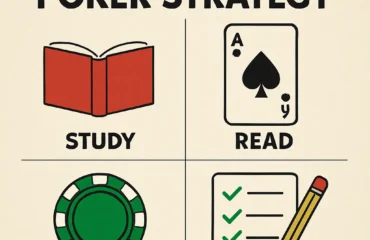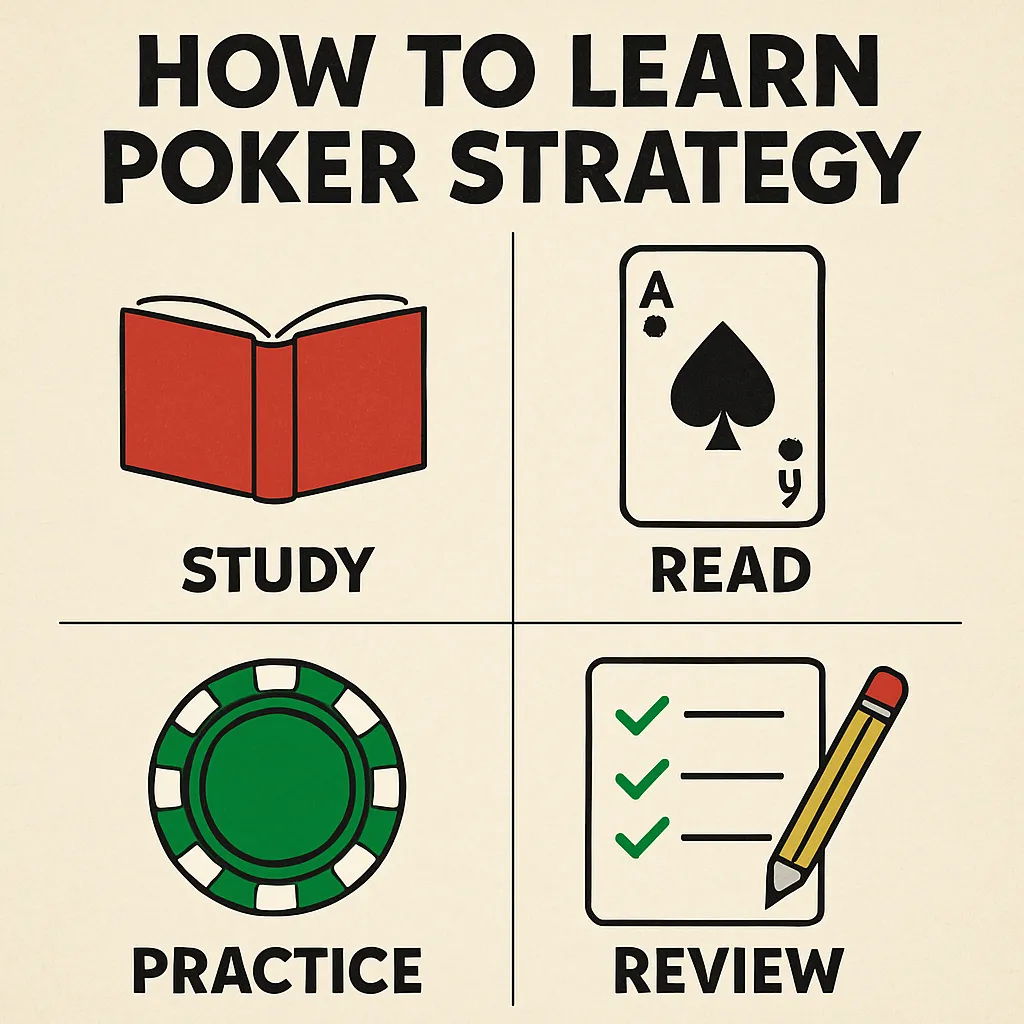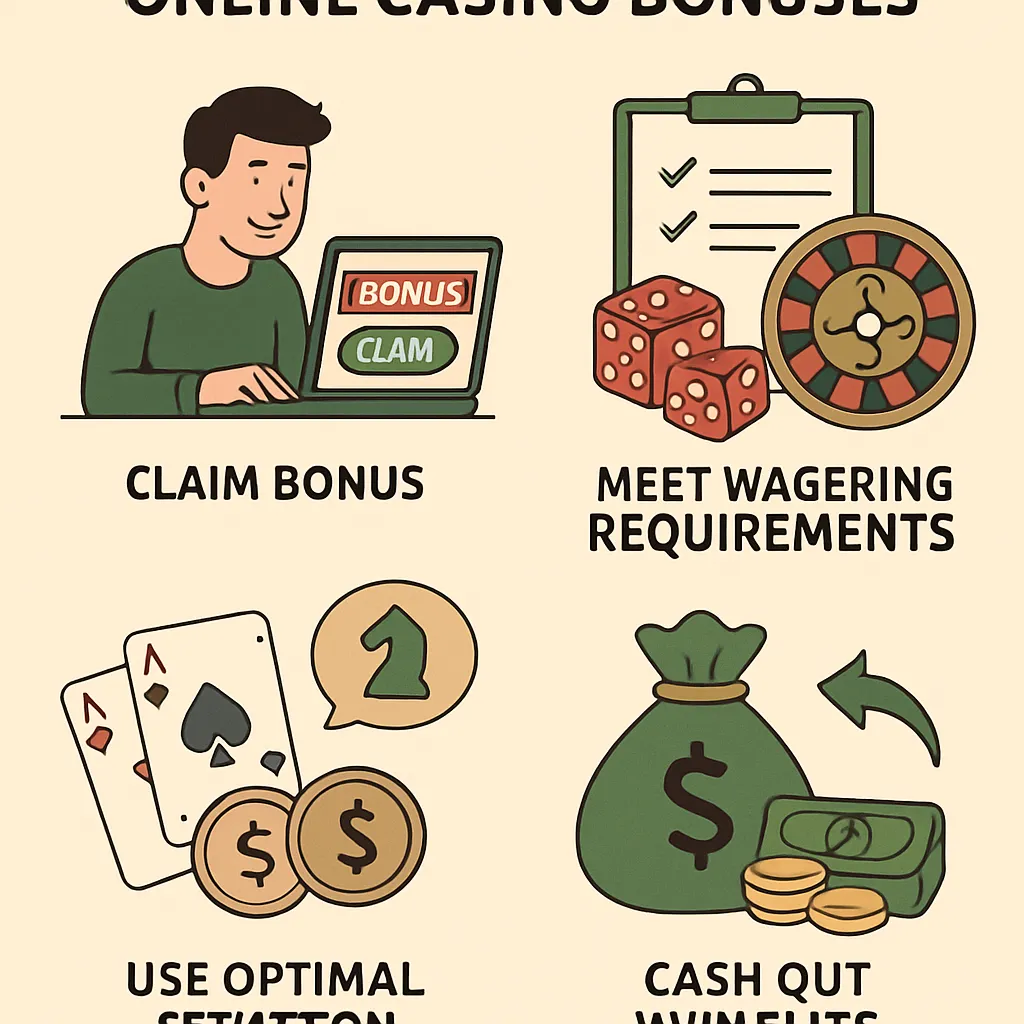How to learn poker strategy
2025-08-03

The estimated reading time for this post is 696 seconds
Mastering poker strategy is a journey that combines mathematics, psychology, and experience at the tables. In this guide, we will address the core question: how can you systematically learn poker strategy to improve your win rate? Whether you are a beginner looking to understand the basics of hand selection or an intermediate player aiming to refine bluffing techniques, this comprehensive guide covers every essential element. You will learn not only the fundamentals of poker math and position play but also advanced tactics like reading opponents and adjusting to different poker variants. By following the structured approach outlined here, you’ll gain the knowledge and confidence to compete at any level. Let’s dive into the world of poker strategy and discover how to develop a winning mindset at the table.
Understanding the Fundamentals of Poker
Before diving into complex plays, it’s crucial to build a solid foundation by understanding the fundamental principles of poker strategy. The game is built around hand rankings, position, and basic betting structures, which together dictate your decisions on every street. Learning these elements thoroughly will give you a framework for all future strategy adjustments. Grasping the basics also helps you avoid common beginner mistakes, such as playing too many weak hands or misreading the board. Once you master the core concepts, you can layer more advanced tactics like bluffing and pot odds effectively. Let’s start with the two pillars of every poker hand: hand rankings and table position.
Basics of Hand Rankings
At its core, poker is about making the best possible five-card hand from the cards available to you. Familiarity with the hierarchy of hands is non-negotiable for any serious player. From the high card up to the royal flush, each tier determines the winner in a showdown. Knowing these rankings by heart allows you to quickly assess hand strength and make informed decisions. Over time, recognizing when your hand is strong or vulnerable becomes second nature. This fundamental knowledge lays the groundwork for more advanced evaluations such as drawing odds and expected value calculations.
Consider how often you’ll see a flush compared to a straight or full house; understanding these probabilities helps you gauge risk. For instance, flush draws occur more frequently than full house draws, which affects how you should bet and call in the middle rounds. Practice by reviewing hand rankings until you can recall them instantly. Flashcards or mobile apps can accelerate this memorization. Ultimately, your ability to categorize hands quickly under pressure will enhance your overall poker strategy.
The Importance of Position
Position at the poker table refers to where you act in relation to the dealer button and other players. It is perhaps the single most important strategic factor in poker strategy. Being “in position” means you act after your opponents, giving you crucial information about their actions before making your own decision. Conversely, playing “out of position” forces you to act with less information, often leading to costly errors. Over time, recognizing the value of late position relative to early position can tilt the odds in your favor.
Beginner players often overlook position, focusing solely on hand strength. However, even marginal hands can be profitable in late position due to the informational advantage. Conversely, strong hands should be played more cautiously in early position to avoid multi-way pots that can diminish your equity. By integrating position awareness into your pre-flop and post-flop decisions, you’ll dramatically improve your win rate. As you progress, you’ll learn to exploit opponents’ positional mistakes and maximize the value of premium hands.
Developing Your Poker Strategy
With the fundamentals in place, you can begin to tailor a poker strategy that fits your playing style and bankroll. Key elements of a robust strategy include selective starting hand play, balanced aggression, and an understanding of poker math concepts like pot odds and expected value. Adopting a tight-aggressive style initially will help you avoid marginal situations while building confidence. From there, you can layer in advanced techniques such as bluffing and semi-bluffing. Let’s explore the building blocks of an effective approach to poker strategy.
Starting with Tight and Aggressive Play
A tight-aggressive (TAG) approach means playing fewer hands but betting and raising more often when you do play. This strategy leverages strong hand selection and controlled aggression to pressure opponents. By focusing on premium hands in early position and widening your range in late position, you maintain a solid foundation. Consistent aggression makes your opponents pay for speculative draws and punishes passive play. This disciplined style also reduces variance, which is critical when managing your bankroll during losing stretches.
To implement TAG effectively, start by playing only top-tier hands from early positions—typically pocket pairs and high Broadway cards. In later positions, introduce suited connectors and one-gappers to your range for balance. Always be mindful of stack sizes and table dynamics. Observe how opponents react to your aggression and adjust your bet sizing to maximize value. Over time, this approach will form the backbone of your poker strategy, allowing you to transition smoothly into more complex plays.
Mastering Bluffing Techniques
Bluffing is a hallmark of advanced poker strategy, enabling you to win pots without the best hand. However, effective bluffing requires a nuanced understanding of opponent tendencies, board textures, and timing. A well-executed bluff can exploit tight players who fold too often or create confusion at the table. Conversely, poorly timed bluffs can cost significant chips and damage your table image. Learning when and how to bluff is essential for taking your game to the next level.
Key factors in successful bluffing include having a credible story, selecting the right opponent, and choosing ideal board textures—those that likely missed your perceived range. Semi-bluffs, where you have equity with a drawing hand, combine bluffs with potential to improve, reducing risk. Practice by noting opponents’ fold frequencies and aggression levels. When used sparingly and strategically, bluffing becomes a powerful tool in your poker strategy arsenal. Remember, balance is vital: don’t bluff so often that observant players adjust and start calling you down light.
Pot Odds and Expected Value
Pot odds and expected value (EV) are mathematical cornerstones of any solid poker strategy. Pot odds compare the current size of the pot to the cost of a contemplated call, helping you determine whether a call is profitable in the long run. Expected value quantifies the average amount you can expect to win or lose from a particular decision over time. By mastering these concepts, you eliminate guesswork and make objectively sound choices.
To calculate pot odds, divide the amount you must call by the total pot size after your call. Then compare this ratio to your estimated odds of completing your draw. If your drawing odds exceed the pot odds, a call is +EV. Expected value combines both pot odds and the probabilities of various outcomes to guide decisions like betting, raising, or folding. Regularly practicing these calculations will build your intuition, allowing you to make quick, profitable decisions during play. Ultimately, integrating poker math into your strategy is non-negotiable for serious improvement.
Enhancing Your Poker Skills
Once you have a working strategy based on the fundamentals and mathematics of the game, it’s time to refine your skills through observation, adaptation, and specialized study. The best players constantly analyze opponents’ behavior, adjust to table dynamics, and explore new poker variants to broaden their expertise. By focusing on these areas, you’ll gain a competitive edge and stay ahead of the field. Below, we examine two critical aspects of skill enhancement that can transform your game.
Recognizing Opponent Patterns
Successful poker strategy isn’t just about your own cards; it’s equally about understanding your opponents. Recognizing betting patterns, timing tells, and physical cues in live games gives you insight into their likely holdings. In online poker, focus on bet sizing tells, timing patterns, and frequency of aggression. Keep mental or digital notes on opponents’ tendencies—whether they fold under pressure, over-bluff, or only play premium hands. This opponent-specific intelligence enables you to exploit weaknesses consistently.
To build a reliable opponent database, use session reviews and hand history analysis. Identify frequent callers, maniacs, and tricky players who mix up their play. Adapt your poker strategy by targeting the fish at the table for value and avoiding traps set by strong opponents. Over time, this pattern recognition becomes instinctive, allowing you to make adjustments mid-hand and turn marginal spots into profitable opportunities.
Adapting to Different Poker Variants
While Texas Hold’em is the most popular form of poker, mastering additional variants like Omaha, Seven-Card Stud, and mixed games expands your understanding of poker strategy and keeps your mind sharp. Each variant emphasizes different skills: Omaha often involves larger hand combinations and nut awareness, while Stud requires memory and deduction based on upcards. By learning these games, you gain transferable insights into hand reading, range construction, and pot control.
Begin by studying the specific rules and hand dynamics of each variant. Practice bankroll management accordingly, as loose games like Omaha can have higher variance. Participate in low-stakes mixed game tables to apply your skills without risking significant bankroll. The experience gained from diverse formats enhances your overall poker intuition and makes you a more adaptable, well-rounded player. Embracing variety in your play will enrich your poker strategy toolkit and prepare you for any game you encounter.
Resources for Learning Poker
Continuous learning is a hallmark of successful poker players. Fortunately, a wealth of resources exists to support your development, including books, courses, online communities, and software tools. The right combination of study materials and practice environments accelerates your growth. Below, we explore top recommendations to help you stay informed, motivated, and connected with the broader poker community.
Recommended Books and Courses
Books remain a cornerstone of poker education, offering in-depth theory and real-world examples. Classics like “Harrington on Hold’em” by Dan Harrington and “The Theory of Poker” by David Sklansky provide foundational insights into poker strategy. For more modern perspectives, “Modern Poker Theory” by Michael Acevedo delves into game theory optimal (GTO) concepts. In addition to books, structured online courses from renowned coaches can accelerate learning through interactive lessons and quizzes. Platforms like Run It Once and Upswing Poker offer comprehensive curriculums tailored to different skill levels.
Invest time in one or two core texts before branching out to specialized topics such as exploitative play or advanced GTO solvers. Balance theory with practical exercises, such as solvers and range drills. By combining reading with active problem-solving, you solidify your understanding and apply concepts effectively at the tables.
Online Communities and Forums
Interacting with fellow players in online communities fosters knowledge sharing and provides real-time feedback on hands and strategy debates. Websites like TwoPlusTwo and Reddit’s r/poker host vibrant discussions on poker strategy, hand analysis, and tournament reports. Engaging in these forums exposes you to diverse viewpoints and innovative tactics. You can post intriguing hands for analysis or learn by reviewing threads on trending topics like Metagame adjustments and metagame shifts.
To make the most of online communities, participate regularly by asking insightful questions and sharing your experiences. Respect community rules and provide constructive feedback to others—this reciprocity builds rapport and deepens your own understanding. Over time, you’ll build a network of peers and mentors who can guide your poker journey, offering tips that complement your formal study materials.
Poker Software Tools
Modern poker strategy development often involves specialized software tools that analyze your play and simulate optimal strategies. Hand history trackers such as PokerTracker and Hold’em Manager record your sessions and generate detailed statistics on your tendencies and performance. Equity calculators like Flopzilla and GTO solvers such as PioSOLVER allow you to dissect specific scenarios and study balanced strategies. Utilizing these tools helps you identify leaks—weaknesses in your game—and test improvements.
Begin by integrating a hand tracker into your play routine to collect data on key metrics like VPIP, PFR, and aggression factor. Then, use an equity calculator to practice pot odds and draw scenarios. Finally, explore solver outputs to understand balanced lines in tricky spots. Leveraging poker software tools accelerates your learning curve and ensures your poker strategy evolves with the latest theoretical advancements.
Key Poker Hand Rankings
Below is a quick-reference table of poker hand rankings, from highest to lowest. This table will serve as a handy guide whenever you need to recall which hand wins in a showdown. Refer back to this table often as you study and play.
| Rank | Hand Name | Description |
|---|---|---|
| 1 | Royal Flush | A, K, Q, J, 10 of the same suit |
| 2 | Straight Flush | Five consecutive cards of the same suit |
| 3 | Four of a Kind | Four cards of the same rank |
| 4 | Full House | Three of a kind plus a pair |
| 5 | Flush | Five cards of the same suit, not consecutive |
| 6 | Straight | Five consecutive cards of mixed suits |
| 7 | Three of a Kind | Three cards of the same rank |
| 8 | Two Pair | Two different pairs |
| 9 | One Pair | Two cards of the same rank |
| 10 | High Card | The highest card when no other hand is made |
Practical Steps to Improve Your Poker Strategy
Armed with theoretical knowledge and resources, you need a clear action plan to put your poker strategy into practice. Below are concrete steps you can follow to structure your study and playing sessions. Implementing these steps consistently will accelerate your improvement and solidify your understanding of key concepts.
- Review and memorize the hand ranking table to ensure instant recognition of hand strengths.
- Practice pot odds and equity calculations daily using an online equity calculator or poker app.
- Adopt a tight-aggressive style in your next 1,000 hands to reinforce disciplined play.
- Track your sessions with a hand history tool and analyze results weekly to identify leaks.
- Participate in online poker forums at least twice a week to discuss hands and strategies.
- Study one poker book or course module per month and apply lessons directly at the tables.




